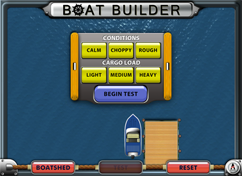Boat Builder

Which type of boat hull is the most efficient for transporting heavy equipment? What about going fast in calm waters? Which type of boat hull do you choose if you need to make a long trip in rough seas? Your challenge is to find out which types of boats are the best suited for these different situations. Are you ready? Then it’s time to hit the high seas!
What is a displacement hull?
A displacement hull has a rounded shape and pushes the water around the hull when it moves. Displacement hulls are typically limited to lower speeds because of this. However, they tend to be very stable in rough surface conditions and can carry heavy loads. An example of a displacement hull is a round hull. Displacement hulls are very efficient at low speeds, and as such they typically don't need powerful motors.What is a planing hull?
A planing hull is a type of hull that is designed to allow the boat to plane. Planing is when the boat rides on top of the water instead of moving through the water like a displacement hull. Planing can only be achieved by special hulls at high speeds; thus, planing boats usually have a flat hull and a powerful motor.What is a semi-planing hull?
A semi-planing hull is a combination of a displacement hull and a planing hull. At low speeds it can act like a displacement hull, but it can also plane (though not as well as a pure planing hull) at high speeds. It isn't quite as stable in rough seas as a pure displacement hull because it has a shallower shape, but can go much faster than a displacement hull. An example of a semi-planing hull is a shallow vee hull. This type of hull is shaped like a gentle V with the deepest part at the center of the boat.What is antifouling paint?
Antifouling paint is a special type of paint that kills barnacles and other organisms that would otherwise grow on the hull. If organisms grow on the hull, the hull could be damaged and would be subjected to much more drag, therefore decreasing the efficiency of the boat. Modern antifouling paints also often protect against corrosion on the hull and improve the flow of water past the hull, and therefore increasing the efficiency of the boat.What is the difference between an outboard motor and an inboard motor?
An outboard motor is attached to the rear of the boat. The propeller is located on the bottom of the motor. When the boat turns, the entire motor turns to push the boat in that direction. Because of this, no rudder is needed. Inboard motors, on the other hand, are housed inside the hull, and the propeller extends to the rear of the boat. A rudder is used to control the direction that the boat moves in. Inboard engines typically last longer than outboard engines, because they are sheltered from the elements.What are trim tabs?
Trim tabs can be attached to the bottom of outboard motors to help adjust the angle at which the boat moves through the water. Trim tabs can be adjusted depending on the speed of the boat and the surface conditions. They help keep the boat level in the water, which both makes it easier for the helmsman to control the boat and increases the efficiency of the engine.Walkthrough
Tier 2 Lessons: Grades 7 - 12+
You need to log in to access this simulation.



